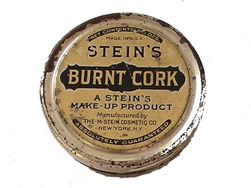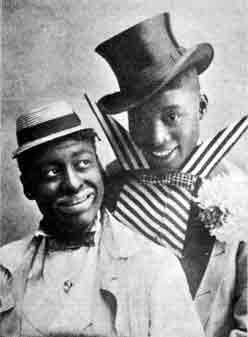Vaudeville and Race
 Vaudeville intersected critically with race in several different ways.
Vaudeville intersected critically with race in several different ways.
First, it was a descendent of 19th century minstral shows. In these shows, white performers in blackface joked, sang, and imitated African American stereotypes. Burnt cork (pictured left) was used to create blackface. Minstral shows included a set of racist characters: Mr. Tambo and Mr. Bones were the end men who sat at each end of the semicircle of performers. The Interlocutor who was the MC of the show, generally sat in the middle. Shows included characters like "Jim Crow," (an archetypal slave character) and "Zip Coon" (a character intended to mock free blacks).
There were African American performers in minstral shows but, for white audiences, they generally performed in blackface figuratively and sometimes literally. Figuratively, they performed the same stereotypes that whites in blackface performed. Literally, they sometimes wore burnt cork. The blackface performance hung on in vaudeville. It was common before World War I, and racist stereotypes persisted afterwards, arguably to the current day. You can read a good history an analysis of blackface at this link (optional).
 However, second, in some limited ways, vaudeville was racially progressive. The vaudeville commedian Joe Laurie Jr. supposedly said that talent has no color. And, it was certainly true that vaudeville was full of African American performers. It was by far the most promenent way that black performers moved into the mainstream. Bert Williams and George Walker (pictured left with Williams in blackface) were early successes in the 1890s. However, almost every African American performer from the first half of the 20th century started in vaudeville. These include Louis Armstrong, Fats Waller, Bill "Bojangles" Robinson, Duke Ellington, Pearl Bailey, Josephine Baker and many, many others.
However, second, in some limited ways, vaudeville was racially progressive. The vaudeville commedian Joe Laurie Jr. supposedly said that talent has no color. And, it was certainly true that vaudeville was full of African American performers. It was by far the most promenent way that black performers moved into the mainstream. Bert Williams and George Walker (pictured left with Williams in blackface) were early successes in the 1890s. However, almost every African American performer from the first half of the 20th century started in vaudeville. These include Louis Armstrong, Fats Waller, Bill "Bojangles" Robinson, Duke Ellington, Pearl Bailey, Josephine Baker and many, many others.
Black performers faced enormous difficulties on the road. Although they were usually treated well by their fellow vaudville performers and by the owners (or, anyway, as well as they treated anyone), they generally lived in far worse conditions than white performers and sometimes faced hostility from the public. In most (but not all) cases, African Americans were permitted to enter theaters to see vaudeville performances. But, as was later true with movie theaters, they sometimes had their own entrances and were limited to balcony seats or seats at the back of the theater.
In response to these conditions, African Americans started their own vaudeville theater circuit. This began with the work of Sherman H. Dudley (1872-1940). Dudley was a vaudeville performer who began buying theaters in the Washington D.C. area around 1911. By the mid 19-teens he had established the "Dudley Circuit," a vaudeville circuit in the mid-Atlantic and mid-west states that booked black artists and played to black audiences. In 1920, the Dudley Circuit merged into the Theater Owners Booking Association or T.O.B.A. Of course, black audiences had less money than white audiences and as a result T.O.B.A. paid less and had substantially worse touring conditions than the white owned companies. It's performers sometimes referred to it as "Tough On Black Artists." As nickolodean films increasingly took over from vaudeville, the theaters of the T.O.B.A. circuit frequently converted to movie houses showing "race" films.
Back to Edison's Camera